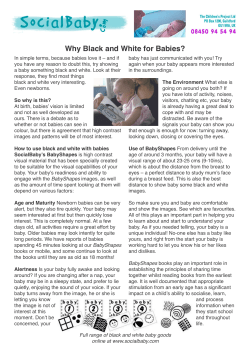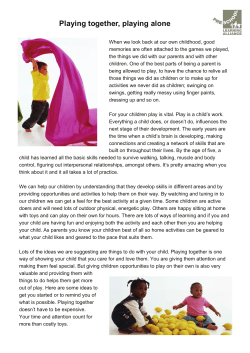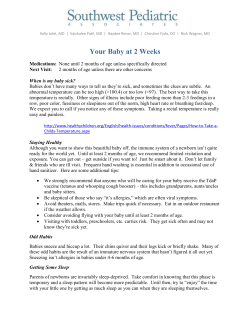
Guide to Bottle-feeding Infant feeding (Newborn to six months old)
Infant feeding (Newborn to six months old) Guide to Bottle-feeding How to prepare formula and feed your baby safely Breastmilk is the baby’s best food Breastmilk is the best source of nutrients for your baby to meet his needs for growth and development. It contains many valuable ingredients, such as antibodies, living immune cells and enzymes. It helps your baby to build up immunity, and reduce the chances of having diarrheas, chest infection and hospital admissions. It contains substances, which cannot be obtained from infant formula, that help both the digestion and absorption of nutrients. Breastfeeding is not only convenient, time and money saving and environmental friendly. It also enhances the bonding between mother and baby, strengthens the baby‘s sense of security. Early initiation and frequent breastfeeding increase the chance of success in breastfeeding. Breastfeeding helps maternal uterine contraction, diminishes postpartum hemorrhage and anaemia. It also facilitates the mother to return to her physical shape. The risk of ovarian and breast cancer are lowered for mothers who ever breastfed. 1 When you choose to feed your baby formula milk, you should consider the followings: Powdered Infant formula does not provide babies with any antibodies. 1 It is not a sterile product and may contain harmful bacteria. Inappropriate preparation, and handling of the reconstitution procedure put the baby at risk of infection. Babies, who are fed with formula milk will swallow much more air during feeding, and are more likely to pass sticky stool and have more gastrointestinal problems. Powdered Infant formula is costly. Parents need to spend a considerable sum on the milk powder that the baby consumed during the first year. ( For example: if a baby consumes 3-4 cans of 900 gm infant formula per month and each can is worth $ 250. His parents need to pay $ 9000-12000 in the first year just for the formula milk). Parents also have to spend addition money on bottles, teats as well. Furthermore, many natural resources are used during the manufacturing and reconstitution process of the formula milk. Breastmilk is the most ideal food for your baby. Your body will make less breastmilk once you start to feed your baby with formula milk. You may find it difficult to switch back to breastfeeding. Nonetheless, for situations that the mother is unable to breastfeed or the parents have decided not to breastfeed, safe preparation of the formula milk and proper handling in bottle feeding is essential to reduce the risk of the baby contracting infections. 1: Safe preparation, storage and handling of powdered infant formula – Guidelines. WHO 2007 2 How to Choose the Appropriate Formula? < Infant formula> Is mainly made from cow’s milk. It is suitable for healthy newborn babies. Provides the necessary nutrients to meet the daily requirement of your baby. Babies can continue taking infant formula above six months of age. Various brands of infant formula are similar in terms of their composition. There is no advantage of switching one to another. <Special formula> Should only be used for baby with the special health needs. They should be used under doctors’ direction. For example: Lactose free formula or soy-based formula is indicated for babies who cannot tolerate lactose (the sugar found in cow's milk). Strict vegetarian parents may choose to feed their babies with soy-based formula as it contains no animal components. Hydrolyzed-protein formula is for babies who cannot tolerate cow's milk protein. < Follow-up formula> IS NOT SUITABLE for babies under six months of age The immature kidneys are unable to handle the formula leading to dehydration, gastroenteritis or brain damage in newborn babies. 3 How to choose the bottles and teats? When choosing feeding bottle, you need to note: Material of the glass or plastic bottle that complies with international standards. The bottle is clear so that the inside of bottle is visible. The pattern or colour on the bottle should not detach easily and the dye used is harmless. It should be easy to clean The size should be appropriate Choose plastic bottles that are made from safe materials complied with the standards of the Food and Drug Administration of the United States (FDA) or the European Food Safety Authority, EFSA When choosing teats, you need to note: The size of the teat should be appropriate for the baby. The shape and the material of the teat generally do not make much difference in feeding. teats are more durable. Latex teats are softer and flexible. Silicone It is relatively firmer can stay in the original shape longer. The size of the hole of the teat should be appropriate such that the milk drips from the teat at about one drop per second when tipped. If the hole is too small, baby needs lots of effort to suck. When the hole is too large, the milk flows too fast, baby may be choked. Regularly check the condition of the teats and bottles. Discard any items that are torn, cracked or damaged. 4 How to Clean and Sterile Feeding Bottles? All feeding bottles, teats, and other devices you use to prepare formula milk or feed the baby should be thoroughly cleaned and sterilized before use. 1. Cleansing and sterilizing the feeding devices ( bottles, teat and tongs) Before handling the devices, always wash your hands with soap and water. (Please refer to the leaflet "Guidelines for Good Hand washing" ) Clean the feeding bottle and teat in soapy water. Use a bottle brush to scrub the inside and outside of the bottle and teat. Then rinse thoroughly in running water. i. Sterilizing the devices, you can choose the following methods: Sterilizing by Boiling : Put the feeding devices into a pan and cover them with water. Cover the pan with a lid. Bring it to a boil and then boil for 10 minutes. Turn off the gas and let it cool down. ii. Steam sterilizing (such as using electric sterilizer) Follow the manufacturer’s instructions for sterilization. Make sure the openings of the bottles and teats are facing down in the sterilizer iii. Using chemical sterilizing solution Follow the manufacturer’s instructions for sterilization and to change the sterilizing solution regularly. Ensure that there is no trapped air bubbles in the bottles or teats. Keep all the equipment under the solution with a floating cover. 2. Removing the sterilized feeding devices from the pan or sterilizer: First, wash hands thoroughly. Then use a sterilized tongs to remove the devices just before it is to be used. If they are not used immediately, put together the bottle, the teat and the lid and store in covered containers. 5 How to prepare a powdered formula feed? It is crucial to follow the correct steps in preparing formula feeds and consume the freshly prepared feed immediately in order to minimize the risk of bacterial infection. 1. Boil a sufficient volume of fresh tap water. If using an electric kettle, wait until the kettle Use hot water no less than 70C to make up formula feeds & this kill harmful bacteria switches off; otherwise make sure that the water comes to a rolling boil. 2. Clean the area where you are going to prepare feeds. 3. Wash hands thoroughly with soap and water and dry with a clean cloth. 4. Shake off any excess liquid from the bottle and the teat, or rinse the bottle with boiled water from the kettle if using chemical solution for sterilization. 5. Pour the needed amount of hot water of no less than 70ºC (water left in the kettle for no more than 30 minutes after boiling) into the bottle. 6. Add the exact amount of formula powder to water as instructed on the label. Adding more or less powder than instructed could make infants unwell. Fill the scoop provided in the formula can loosely with formula. 6 Level it off using the flat edge of a clean and dry knife. 7. Attach the bottle, the teat and the cap, and then shake the bottle until the powder is dissolved. 6 7 8. Place the bottom half of the bottle under cold running water or put it in a basin of cold water to cool down the milk to a 8 temperature suitable for feeding. Ensure that the cooling water does not touch the cap covering the teat. 9. Dry the bottle surface with a clean cloth/paper towel. Then check the temperature of the formula milk is suitable for feeding (see next page). Consume the formula as soon as possible. Discard any prepared feed if not consumed within 2 hours. Can I use bottled water to make up formula feeds? It is not advisable to make up feeds using mineral water as the mineral levels may not be suitable for babies. If you use bottled distilled or mineral water, you should ensure it is boiled. How to store a prepared feed? Powdered infant formula is not a sterile product. To reduce the risk of infection, feed should be freshly made up when it is needed. Under room temperature, a made up formula feed should be consumed within 2 hours after preparation. Feeds prepared in advance should be cooled immediately after preparation and stored in a fridge below 4 °C. Do not store longer than 24 hours. Re-warm the refrigerated feed in no more than 15 minutes by placing in a container of warm water with occasional swirl. Ensure that the level of the water should be below the top part of the bottle. Use the re-warmed feed within 2 hours, discard otherwise. Do not heat any feeds in the microwave, the liquid may be heated unevenly and scald your baby. 7 How to Feed the Baby? Before feeding the baby, wash your hands thoroughly using water and soap. (Please refer to the leaflet "Guidelines for Good Hand Washing”). Follow the steps below when you feed her. 1. Pour a few drops of the warmed 2. Hold your baby close to you in milk onto your wrist to ensure the temperature is suitable for feeding. your arms, with her head a little higher than the rest of the body. 3. Tilt the bottle. Lightly touch the 4. Hold the bottle so that the formula baby’s mouth with the teat and the baby will turn and grasp it. milk covers the teat. This prevent her from swallowing air during sucking 5. When your baby shows signs of fullness (e.g. stop sucking, no longer interested in sucking or turning away from the bottle, you should stop feeding). Observe the pace and the baby’s effort used in sucking. If the teat hole is too small, baby needs lots of effort to suck. O n the other hand, baby suck very fast if the teat hole is too large. Please consult health professionals for any concern if the problem is not related to the teat hole size. 8 Important Notes Don’t force your baby to finish all the milk in a bottle. Left-over milk should be discarded. Don't leave your baby alone with the bottle propped up. She may choke on the milk or have the risk of suffocation. Don't let her sleep with a bottle as it may lead to tooth decay. How to burp the baby? Burping your baby help relief the discomfort caused by the air swallowed. Burp him when he finishes the feed. You can also burp him after feeding 60-90 ml or as he pauses. Hold your baby in either one of the following positions: Hold him upright, support his head on your shoulder while you gently pat or rub his back. Sit him on your lap, support his chest and head with one hand while you gently pat or rub his back with another hand. Keep your baby in an upright position for 10 to 20 minutes to prevent him from spitting up after feeding. 9 How much milk a baby needs in a day? Newborn babies may take only small amounts of infant formula in the first few days. Towards the second week, they require more milk. The amount of milk needed varies from baby to baby. Most babies settle into their own feeding pattern, but they differ in how often they feed and how much they want to take. Some may feed little but often. Some may take more but less frequently. Your baby knows best how much he needs. You should get to know his signs for feeding and feed him when he wants and stop when he gets full. Baby is Ready to Feed, if he Baby gets full, if he Wakes up and moves Stops sucking Moves his head and Spits out the teat opens the mouth Falls asleep Sucks his fist or hand Arches his back Cries or fusses when he is very hungry Offer the Baby Milk Stop Feeding Your baby is getting enough milk if, a few days after birth, he: Produces about six soaked nappies a day, passes urine in pale yellow colour. Passes yellowish stool. Gains weight in satisfactory pace (weighed naked) Can I give my baby water to drink? Babies do not need extra water as long as they are only on breast feeding or infant formula feed. only in between feeds. 10 You could offer him sips of water Key Points Breastmilk is the best food for your baby. The longer babies are fed on breastmilk, the greater the benefits for the health of mothers and babies. According to the WHO’s recommendation, babies should be breastfed exclusively in the first six months and continue to have breastmilk together with solid food in their diet until two years old or above. The production of the breastmilk will be reduced once you choose to feed your baby with formula milk or introduce solid food too early. And, it is difficult for you to switch back to breastfeeding. Choice of formula Infant formula is suitable for babies from birth to six months and beyond. Changing to follow-up formula is not a must and it should only be given to babies over six months old. Use special formula only after consultation with your doctor. Preparation of milk feeds Always pay attention to personal hygiene and bottle sterilization. Follow instructions strictly in preparing the feeds. Powdered formula milk is not a sterile product. Pay attention to the water temperature of reconstitution and method of storage. Feeding your baby Check the hole of the teat is of a right size. Follow baby's own feeding pattern. Watch for signs of hunger / fullness. Don’t force the baby to drink milk. Discard left-over milk. If you have any queries on bottle-feeding, please consult your doctor or nurse. For more health information, please visit www.fhs.gov.hk or call Family Health Service, Department of Health 24-hour Information Hotline: 21129900 11 FHS-N2A (Rev. June 2012)
© Copyright 2025












